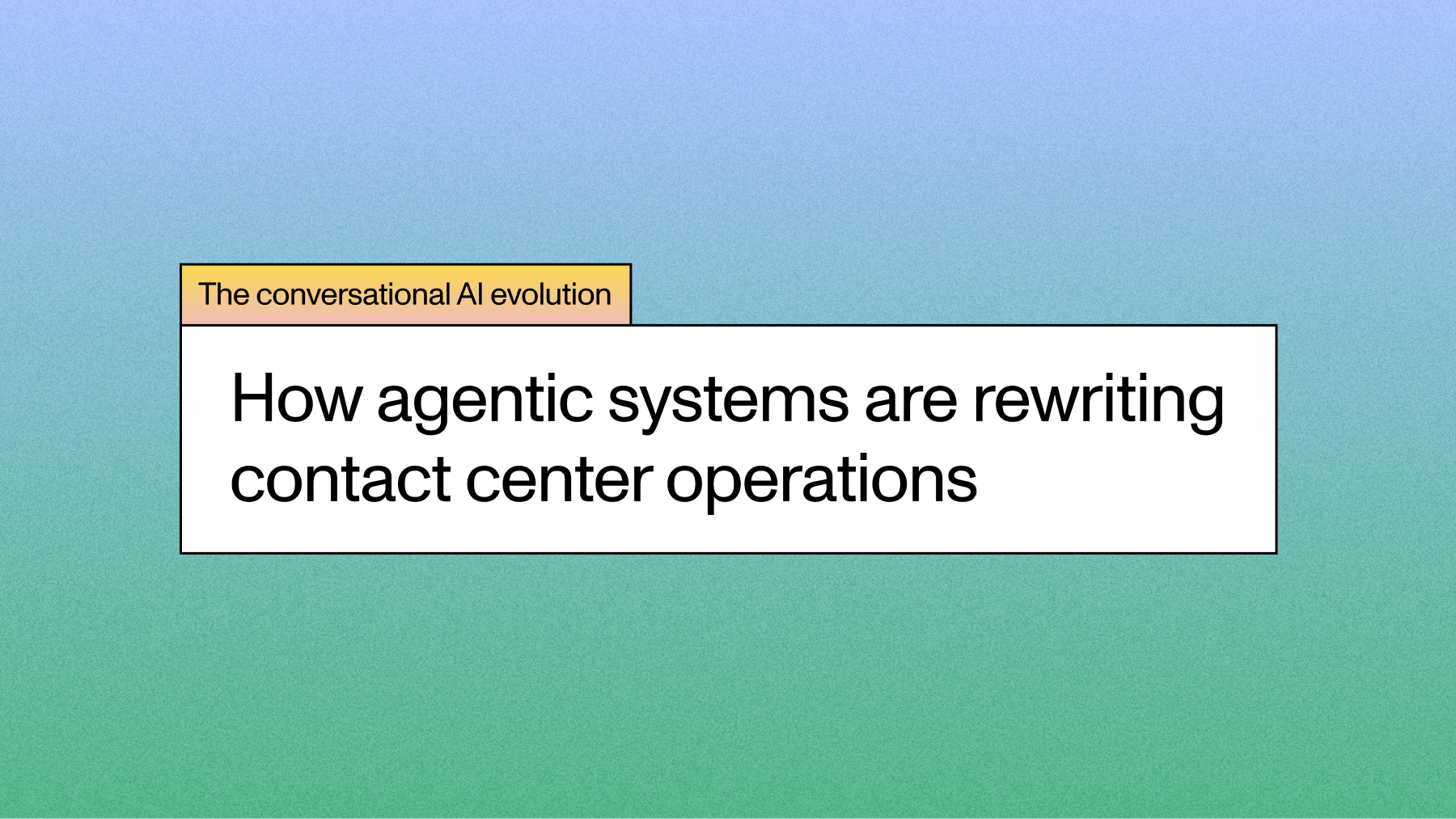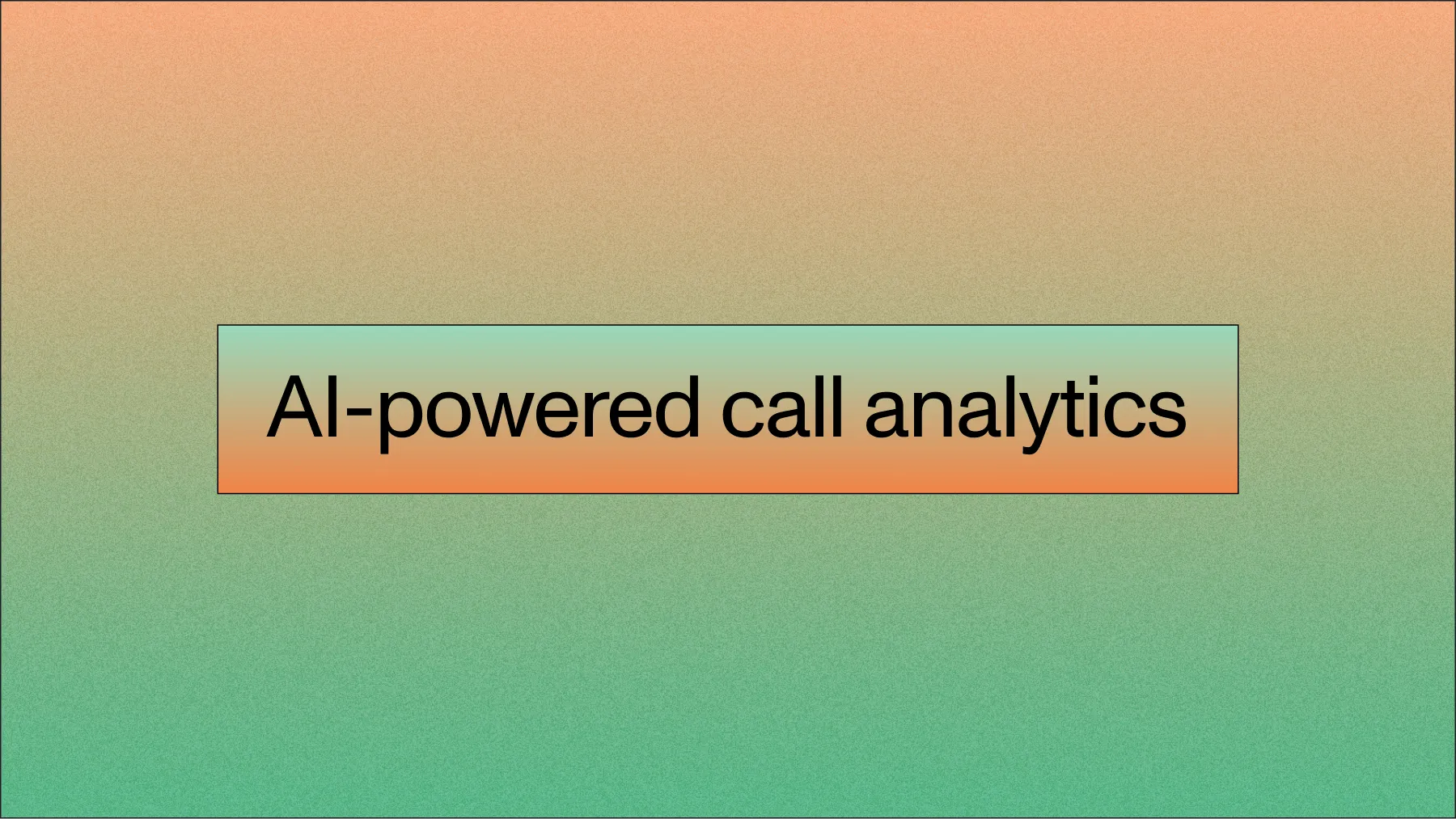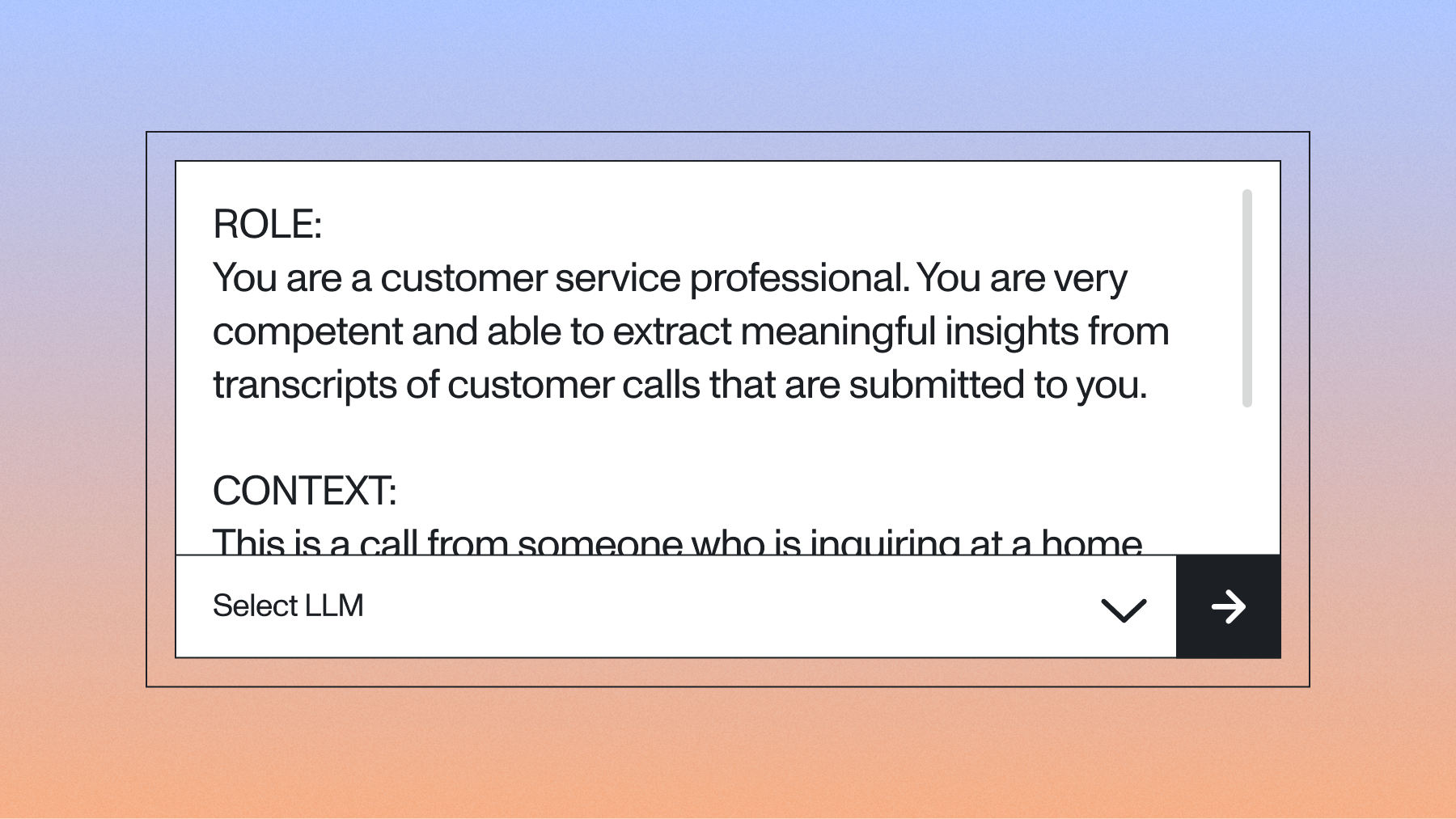The conversational AI evolution: How agentic systems are rewriting contact center operations
Discover how agentic AI revolutionizes contact centers with autonomous issue resolution, real-time decision-making, and conversational intelligence for superior customer experiences.



The agentic AI contact center market is racing toward $7.28 billion by 2025, growing at 43.8% annually. That's not just a tech trend—it's customers voting with their wallets for better service.
Picture agents that never forget a customer's history, never need training on new products, and can handle everything from billing disputes to technical troubleshooting at 2 AM. That's not science fiction; early adopters are already seeing 171% ROI with 45-80% of issues resolved completely autonomously. These aren't chatbots following scripts. They're digital teammates making real decisions.
Here's the reality: organizations aren't upgrading from calculators to better calculators. They're getting financial advisors who happen to work 24/7. All made possible by AI that truly understands human conversation—not just the words, but the intent, emotion, and context behind them.
In this article, we'll show you exactly how companies like JetBlue and American Airlines are transforming their contact centers from cost burdens into competitive differentiation.
What is agentic AI?
Agentic AI represents a fundamental shift in how artificial intelligence operates within contact centers. Unlike traditional AI systems that respond to predefined triggers or follow rigid decision trees, agentic AI possesses the ability to understand context, make decisions, and take autonomous actions to achieve specific goals.
In the contact center context, agentic AI functions as a "digital teammate" rather than a simple tool. These systems can:
- Understand and remember: Process natural language, maintain conversation history, and recall previous interactions across all channels
- Reason and decide: Analyze situations, weigh options, and choose appropriate actions without human intervention
- Act and execute: Access multiple systems simultaneously, complete workflows, and resolve issues end-to-end
- Learn and adapt: Improve performance based on outcomes and adjust approaches for different scenarios
The key differentiator lies in autonomy. While chatbots require customers to navigate predetermined paths, agentic AI navigates the path itself. When a customer says "my bill seems wrong," the system doesn't just categorize the inquiry—it investigates billing history, identifies discrepancies, calculates adjustments, and processes corrections autonomously.
This capability depends on sophisticated conversational AI that truly understands human communication. Advanced speech recognition provides the foundation by accurately capturing speech across accents, background noise, and emotional states—with some models achieving 24% improvement in proper noun recognition, critical for understanding customer names and company references. This transcription accuracy enables the AI to comprehend intent and context, not just words.
Gartner predicts that by 2029, agentic AI will autonomously resolve 80% of common customer service issues without human intervention, leading to a 30% reduction in operational costs. This isn't incremental improvement—it's transformation.
From frustration to resolution: What agentic AI actually does
The contrast between traditional contact center experiences and agentic AI-powered interactions demonstrates the technology's transformative impact. Here's how the same billing issue plays out in both scenarios:
Traditional contact center experience:
Customer: "Hi, I see a charge on my bill I don't recognize"
IVR: "Please say 'billing,' 'technical support,' or 'other'"
Customer: "Billing"
IVR: "Please enter your 16-digit account number"
[Customer enters number]
IVR: "Please hold while I transfer you"
[3-minute hold music]
Agent 1: "Thanks for calling. Can I have your account number?"
Customer: [Sighs] "I just entered it..."
Agent 1: "I'm sorry, I don't see it here. Can you tell me what the issue is?"
Customer: "There's a $47.99 charge I don't recognize"
Agent 1: "Let me transfer you to our billing department"
[Another 5-minute hold]
Agent 2: "How can I help you today?"
Customer: [Now frustrated] "I've already explained this twice..."
Agentic AI experience:
Customer: "Hi, I see a charge on my bill I don't recognize"
AI Agent: "I can help with that, Sarah. I see you're calling from your registered number. I'm looking at your recent bill now. Is it the $47.99 charge from March 2nd you're asking about?"
Customer: "Yes, exactly!"
AI Agent: "I found it—that's from the premium sports package that was added to your account. Looking at your viewing history, it seems this might have been activated accidentally since you haven't watched any sports channels. Would you like me to remove it and credit your account?"
Customer: "That would be great!"
AI Agent: "Done! I've removed the sports package and credited $47.99 to your account. You'll see it reflected within 24 hours. I also noticed you've been paying for the movie package but haven't used it in 3 months. Would you like to remove that too and save another $15.99 monthly?"
Customer: "Oh wow, yes please!"
AI Agent: "All set! Is there anything else I can help with?"
[Total time: 90 seconds]
The difference extends beyond time savings. The agentic AI simultaneously accessed five different systems: customer database, billing platform, usage analytics, credit processing, and account management. It understood context, detected opportunities for additional value, and executed complete resolution without human intervention.
This natural interaction depends on advanced speech recognition working in harmony with decision-making AI. Modern streaming transcription with ~300ms (P50) latency enables natural conversation flow, while sentiment analysis detects customer emotions and adjusts responses accordingly. When the AI senses frustration, it responds with empathy and urgency—just like an experienced human agent would.
Evolution from scripts to strategy: Real business transformation
The technology has evolved significantly from the days of "press 1 for billing." This evolution shows what businesses can now accomplish that was previously impossible.
When a customer says, "I need to change my plan because I'm working from home now," the AI doesn't just process words—it understands context. Through natural language processing powered by accurate speech recognition, it recognizes the life change, analyzes usage patterns, identifies suitable plans, calculates savings, and presents personalized options instantly.
This conversational intelligence transforms every interaction. For recorded conversations, speaker diarization technology can identify who said what, enabling quality monitoring and coaching opportunities. When human agents need to join complex real-time conversations, clear speaker transitions ensure complete context is maintained. The AI's ability to detect emotion through voice analysis means it adjusts approach based on customer state—simplifying explanations for confused callers or expediting service for frustrated ones.
Multi-agent coordination amplifies these capabilities. Different specialized AI agents work together seamlessly: one handles address changes while another schedules technician visits and a third maintains billing continuity. This orchestration happens in real-time, invisible to the customer who experiences only smooth, efficient service.
Real-world transformation: Enterprise success stories
These aren't theoretical benefits—they're actual results from companies implementing agentic AI today.
JetBlue: Holiday chaos becomes manageable
Peak holiday travel brought JetBlue the perfect storm: winter weather disruptions, cancelled flights, and thousands of frustrated travelers needing immediate help. In previous years, this scenario meant overwhelmed agents, hours-long hold times, and social media complaints.
Their agentic AI implementation changed the equation. As calls flooded in, AI agents handled complete customer journeys autonomously: rebooking flights, processing refunds, sending confirmations, and updating travelers in real-time. Human agents focused on complex emotional situations while AI managed the logistics.
The results speak volumes: 45% of issues resolved without human intervention, with each interaction saving an average of 280 seconds. More significantly, customers calling at 2 AM received the same quality service as those calling at noon. The AI understood context—when customers said "I need to get home for Christmas," it prioritized accordingly, checking connections and suggesting alternative airports.
The technology required understanding stressed travelers speaking over airport noise, various accents, and emotional urgency—challenges that modern speech AI handles through improved acoustic models and noise reduction capabilities.
American Airlines: Agents become problem-solvers
American Airlines achieved 50% automation but took a different approach—using AI to transform agent roles rather than reduce headcount.
The key: when AI handles routine tasks, human agents have time to be truly helpful. They solve complex problems, show genuine empathy, and build customer relationships. Customer satisfaction scores improved 11%—not because the AI was friendly, but because human agents were no longer rushed and frustrated.
The insurance game-changer
A major insurance provider implemented multimodal agentic AI, combining voice and visual inputs. Customers can now call about car damage while simultaneously sending photos through the app. The AI processes verbal descriptions, analyzes images, checks policy coverage, and initiates claims in real-time.
What previously took days now happens in minutes. The AI estimates repair costs, schedules adjusters, arranges rental cars, and processes initial payments—all during that first call. Claims processing time dropped dramatically; customer satisfaction soared.
The pattern across all these successes remains consistent: transformation comes from reimagining what's possible when AI truly understands and can act on human communication. Companies like CallRail and Pathlight are seeing similar results, with CallRail doubling their conversational intelligence customers after implementing AI-powered analytics.
The conversational layer: Making AI agents feel human
Most AI implementations fail because they feel robotic. Customers recognize within seconds they're talking to a machine, and their guard goes up. The conversation becomes a battle against the system rather than a path to resolution.
Traditional IVR systems, even those claiming to be "smart," rarely understand beyond keywords. Say "my bill seems wrong" and you might get routed to sales. The frustration damages customer relationships across the board.
Speech recognition isn't just transcription—it's understanding. When modern conversational AI hears "I'm frustrated with my service," it doesn't just convert words to text. It recognizes the emotion, understands the intent, and responds appropriately.
This emotional intelligence multiplies AI effectiveness. Systems that detect frustration adjust their approach—speaking more empathetically, offering immediate escalation options, or proactively suggesting solutions. Happy customers might receive relevant upsell opportunities; confused customers get simplified explanations. Each interaction is tailored to the customer's state, not just their words.
Natural workflow capabilities demonstrate the power of accurate speech understanding. A customer saying "I'm moving next month" triggers an orchestrated response: the AI updates addresses across all systems, schedules service transfers, adjusts billing cycles, and confirms every detail. These complex workflows feel as natural as talking to an experienced service representative.
For contact centers with specialized terminology, emerging prompt-based models like SLAM-1 offer customization with domain-specific terms, achieving higher preference rates in human evaluations for industry-specific conversations. This ensures that whether customers use technical jargon or colloquial terms, they're understood accurately.
Advanced speech AI also provides inclusive service. Whether customers speak with heavy accents, use regional dialects, or call from noisy environments, they receive accurate understanding and appropriate responses. Multilingual support means no customer is left behind due to language barriers. When every customer feels heard and understood, resolution times plummet and satisfaction soars.
Your path to autonomous service: A practical roadmap
Contact center transformation doesn't require wholesale replacement of existing systems. Successful implementations follow a phased approach that minimizes risk while maximizing learning and value.
Phase 1: After-hours pilot (months 1-3)
Start where risk is lowest and impact is highest. While agents sleep, AI handles password resets, appointment scheduling, and basic account updates. This approach maintains 24/7 service availability without overtime costs. Monitor performance metrics, gather customer feedback, and refine the AI's responses based on real-world interactions.
Phase 2: Peak time augmentation (months 4-6)
Once the AI proves itself during off-hours, deploy it during busy periods for specific use cases. Payment processing during month-end rushes or technical troubleshooting during product launches are ideal starting points. Human agents handle complex issues while AI manages routine volume. The key is seamless collaboration—ensuring smooth transitions between human and AI agents so customers never repeat themselves.
Phase 3: Intelligent operations (months 7-12)
With proven success in limited deployments, expand to full intelligent operations. AI handles all routine issues autonomously while humans focus on high-value, complex, and emotionally sensitive interactions. Agents evolve from script-followers to problem-solvers and relationship builders.
Success requires three foundations:
- Clean customer data: AI cannot help if it cannot access accurate information
- Clear use case definition: Start with specific scenarios and expand gradually
- Change management: Transform agents into AI trainers and complex problem solvers—make them partners in the transformation, not victims of it
Gartner warns that 40% of agentic AI implementations fail because organizations skip these foundations. They attempt to automate everything immediately or neglect the human element. The 60% who succeed start small, measure everything, and scale what works.
Modern conversational AI platforms offer API-first architecture that enables this gradual approach. Organizations can enhance existing systems without replacement, starting with one use case and expanding based on proven results. With options ranging from async transcription (starting at $0.37/hour) to real-time streaming (at $0.47/hour), businesses can choose the right solution for their specific needs.
Building your agentic future
The difference between robotic chatbots and truly intelligent agents lies in the conversational foundation. Modern speech AI models, now incorporating advanced LLM capabilities like Claude 3.7 Sonnet and Claude 4, provide the accurate, real-time understanding that makes agentic systems feel human—processing natural language, detecting emotions, and enabling seamless handoffs.
Ready to transform your contact center? The path forward starts with understanding your specific needs—whether that's industry-leading accuracy for agent quality monitoring, real-time capabilities for live agent assist, or comprehensive conversation analytics for sales coaching. The technology exists today to build AI agents that don't just respond—they understand, decide, and delight.
Lorem ipsum dolor sit amet, consectetur adipiscing elit, sed do eiusmod tempor incididunt ut labore et dolore magna aliqua. Ut enim ad minim veniam, quis nostrud exercitation ullamco laboris nisi ut aliquip ex ea commodo consequat. Duis aute irure dolor in reprehenderit in voluptate velit esse cillum dolore eu fugiat nulla pariatur.





